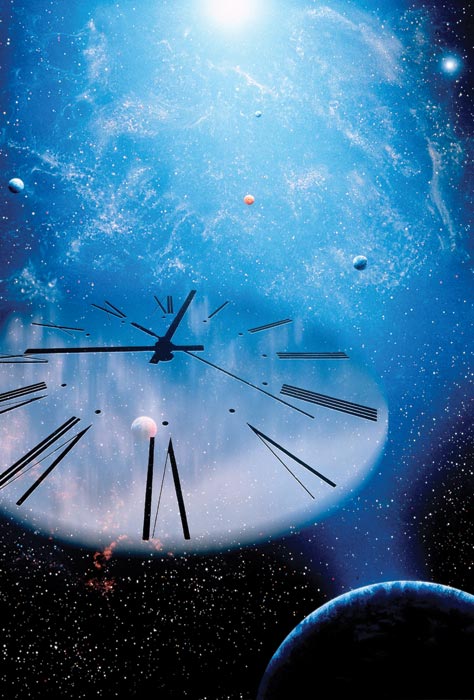Clarissa Ai Ling Lee reviews Philosophy of Physics: Space and Time by Tim Maudlin

Canonical works in the philosophy of physics tend to begin with the Greeks. This practice stems from the philosopher’s need to flag the intellectual tradition from which current physics and its philosophy are derived – albeit with plenty of ruptures, fractures and slippages through the centuries. Even with these bumps in the road, there appears to be a more distinct connection between Greek science, early modern science and the discipline we know today than there is between modern science and the scientific schools of, say, the ancient Indus Valley or Babylon.
The first source of this connection is a set of logical and mathematical formalisms. The second source consists of specific concepts – space, time and matter – that interest modern physicists as much as they did ancient philosophers. The offspring of these two sources is geometry, the flexible mathematical tool that allowed some of humanity’s earliest preoccupations to be translated into tangible scrawls and shapes, ready for thought experiments and demonstrations.
It makes sense, then, for the philosopher Tim Maudlin to begin his latest book, Philosophy of Physics: Space and Time, with geometry – and, more specifically, with that classical Greek-inspired version called Euclidean geometry, which describes the 3D space of our mundane world. Maudlin is also careful to note the physical heritage that accompanied geometry’s introduction, via a brief foray into Aristotle’s Physike Akroasis. There, Plato’s most famous student laid the foundation for thinking about the nature of an object’s motion – something Maudlin returns to later in the book with his discussion of Newton’s laws. By providing such background, he ensures that the reader knows the prehistory of many terms used throughout the book.
Although Maudlin mentions matter in his discussion of the Greek philosophers’ atomistic postulate, and then later, in his account of the philosophical debate between Newton’s supporter, Samuel Clarke, and his great rival, Gottfried Leibniz, he ultimately decided to reserve much of this weighty topic for the forthcoming second volume of the book. In the current volume, he concentrates instead on giving a comprehensive historical overview of the development of the concept of space and time, beginning with an expostulation of Newton’s three laws of motion and continuing as far as Einstein’s special and general theories of relativity.
One of the book’s underlying themes is the way certain aspects of physics have been subject to misconceptions over the years. For example, the book explains how the theory of relativity became a potent source of confusion for those physicists (including, at one point, Richard Feynman) who attempted to frame the theory in terms of the symmetry between the actions of two objects interacting with one another, and external forces that interact with the motion of the objects. The confusion, in Maudlin’s view, comes from a common misunderstanding, even among latter-day scientists, over the question of absoluteness in motion and space, and of the inertial reference frames pertaining to the coordinate system used.
Such confusion has a long history, and in the book, Maudlin describes an interesting early conflict between the claim that all motions are relative and the possibility that absolute motion could exist. This is Newton’s famous “bucket argument”, in which he described a thought experiment featuring a bucket filled with water and hung from the ceiling by a strongly twisted rope. When the rope is released, the water will slosh in the bucket – evidence, in Newton’s view, that a force is acting on the bucket in relation to absolute space. In another thought experiment, Newton imagined two globes rotating about their centre of gravity and connected by a cord. In his view, the tension in the cord is an effect of the absolute rotation of the spheres, since their position in relation to each other is constant. Hence, the globes and the bucket experiments were seen as confirmation of Newton’s theory on absolute space and motion. Newton’s beliefs have not persisted to this day as scientists have stopped believing in the idea of absolute motion.
Modern physics texts re-interpreted Newton’s early geometrical conception of his three laws through the rules of arithmetic, hence stripping them of the form familiar to their inventor. Since the theory of relativity takes Newtonian mechanics as its starting point, Maudlin argues that much confusion would be avoided by using geometrical spatial coordinates, rather than the more often used inertial frame of reference, to explain relativistic effects such as the famous “twin paradox”.
Throughout the book, Maudlin takes much pain to correct what he considers to be misconceptions and confusions about space and time. He may have adopted this strategy because his book is targeted at the non-physicist, and therefore at an audience with no specific investment in other explanations. However, even though the book is meant for the non-specialist, its subject matter is highly technical, and reading it requires constant switching between a philosophical and technical way of thinking. A non-expert reader would have to work patiently through some non-intuitive and potentially confusing points that are not so clearly set out by the author.
Although Maudlin concentrates on pre-quantum physics in the book, he connects some of the questions arising in relativity, such as observability and a discussion of the light-cone, as a way of visualizing events within temporal space to certain experimental conditions in particle physics. This seems like a smart move, given the recent media interest in accelerator physics and experiments at CERN, and the corresponding greater familiarity with these topics among a lay audience. He also touches on the problem of interatomic forces raised in Bell’s Theorem, which builds a discursive bridge between classical determinism and some types of quantum “hidden variables” known as non-locally observable properties. (Maudlin discusses this in more detail in his book Quantum Non-Locality and Relativity: Metaphysical Intimations of Modern Physics.) Such extensions allow the reader a peek at why physical ideas hundreds of years old are still relevant to today’s most cutting-edge problems.
- 2012 Princeton University Press $29.95pb 200pp



